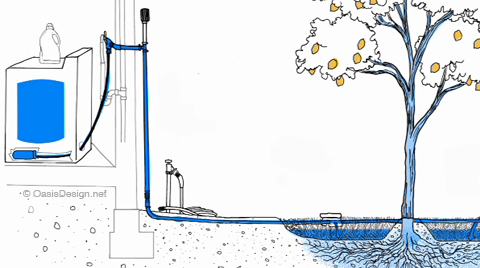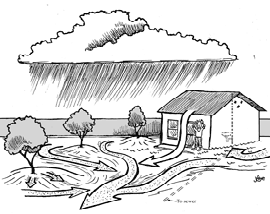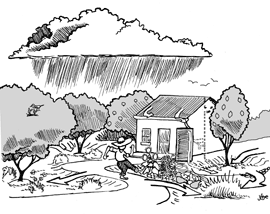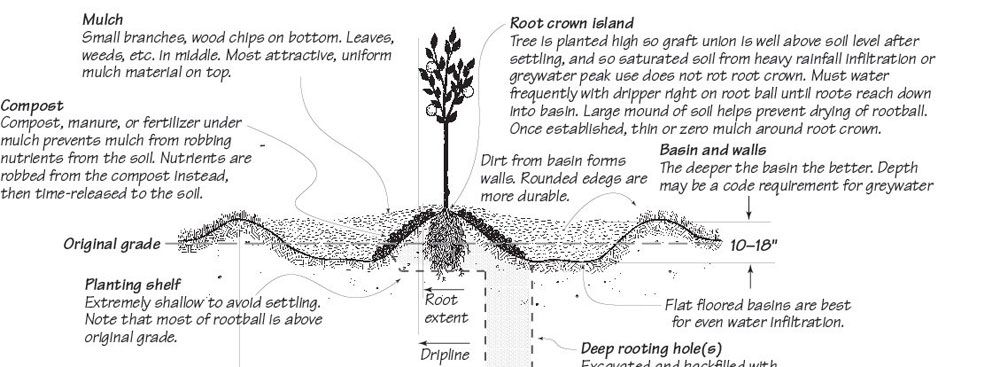Water &Integrated Design Lecture and Workshop Series
With local expert Art Ludwig
in Santa Barbara, California September 30th- November 21st 2014
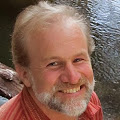
Design for drought, fire, flood, climate; with lawn replacement, greywater reuse, rainwater and runoff harvesting, healthy transportation, and sustainability policy.
Check back for updated information
On this page:
|
Drought Policy Forum
Monday September 22nd, 1-3 pm
Franklin Neighborhood Center, 1136 Montecito St., Santa Barbara
Free
At this event Art Ludwig will briefly describe green infrastructure options for balancing Santa Barbara's water budget.
The hoped-for El Nino has been dissipating. The latest forecast is for continued below-average rainfall, far too little to end the drought. We have just experienced the three worst years of recorded rainfall ever. And current climate models suggest this drought is likely to continue for years.
What are our options? What will they take to implement? What are their costs? What are local water districts and their statewide and worldwide equivalents doing?
Building on the Drought Strategy Forum and Drought Action Forum, the Drought Policy Forum is for key stakeholders in the drought crisis. We will review the most up-to-date information about critical questions like those above. Then we will explore practical policy proposals to sustainably and cost-effectively adapt our community to the drought. Contact us with any proposals you would like to present.
Please join us and invite other stakeholders. Particularly important are water providers and policy makers; landscape, plumbing, construction, business, and real estate professionals; landscape suppliers and nurseries; and environmental advocates and educators.
For more information email Barbara Wishingrad at bwishingrad@gmail.com or call 805-403-4566.
Sponsored by Sweetwater Collaborative.

Sustainable Living Research Initiative Panel and Discussion
Thursday September 25th 2014
1:30 - 4pm
McCune Conference Room, UCSB Campus
The Panel:
Marc Fisher, Vice Chancellor of Campus Design & Facilities, UCSB
Bill Kelley, Chief Building Official, Marin County
Art Ludwig, Ecological/Integrative Design Expert & Author, Oasis Design
Carl Palmer, Sustainable Land Developer/Investor, Legacy Works
Mark Tollefson, Executive Director, Fairview Gardens, Goleta
Meg West, Planning Commissioner, City of Goleta
Facilitated by: Ben Werner, Sama Group
Overview
The Sustainable Living Research Initiative (SLRI) seeks to promote innovation in building, zoning, and health
codes in order to support sustainable development and land use practices. In partnership with local experts
and research/educational institutions, this Initiative aims to create a safe means to regulate and oversee
ladings best practices in sustainable living that will influence the next generation of development.
The SLRI is intended for situations where the following factors are present:
1) Property owners, designers, or researchers interested in innovation
2) Research/educational institutions and local experts available to help design, test, and evaluate projects
3) Local policy makers and regulatory agency staff interested in supporting this Initiative
This question will be the focus of our discussion:
What regulatory framework needs to be in place to support this Initiative?
Context
There is a growing sense of urgency. We need to create options for development and land use that actually
improve and regenerate the ecosystems that support us. There is a long history of efforts to achieve this goal,
including green rating systems and codes that have made much progress on many pieces of the puzzle. The
objective of the SLRI is to create a regulatory framework for innovation that: 1) encompasses the entire
permitting landscape (zoning, public health, fire, building, etc.); 2) allows enough flexibility for kindergartners
integrated systems design together with sufficient oversight to ensure that public safety is protected, and 3)
adheres to the General Plan of the participating municipality.
We look forward to your participation in this strategy-shaping discussion
Invite (pdf)
More info (pdf)
Sponsored by Sama Group

Integrated Design: the optimal, dynamic balance between all the relevant factors
Water Design for Drought, Fire, Flood, Climate, and More
Tuesday September 30th 2014
6 - 7:30 pm
Faulkner Gallery, Santa Barbara Public Library
$12 suggested donation
The first lecture in a series of talks and workshops this Fall, which explains integrated designs for super efficient fixtures, rainwater harvesting, water reuse, non-toxic, low carbon, fire-safe construction and more.
Integrating the solutions to these diverse issues is the key to revolutionary improvements the ecology, economy and sustainability of home, landscape and city. Drought resilience is just one of many benefits from considering all the relevant design factors at once.
This presentation will cover—
- The significance of our place and moment in history
- What can we do now to make the future better
- The necessity for systems thinking
- The water-energy-climate connection
- How to make an accurate, four dimensional map of your context
- Santa Barbara's water budget
- How you can dramatically improve the water budget on your land
- The smart money is on green infrastructure
- The role of humans in the ecosystem; taking the edge off flood and drought
- Rainwater infiltration
- The impact of transportation choices on the water cycle
- Conventional vs integrated design
- Green infrastructure
- How we’ll deal with fire in the future
- Discussion with audience
Target audience: Everyone (especially policy makers, agency staff, landscape architects, landscapers, architects, students and homeowners).
This talk will be technical but accessible. There will be something here for people at all levels of familiarity with these concepts.
Sponsored by Sweetwater collaborative, Santa Barbara Permaculture Network
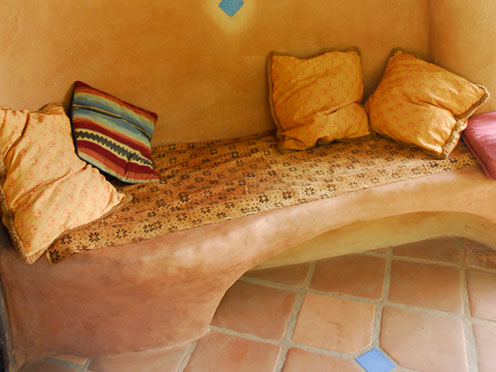
Fireproof, low carbon wall of local adobe
Greywater and Multifunctional Landscapes
Tuesday October 14th 2014
6 - 7:30 pm
Faulkner Gallery, Santa Barbara Public Library
Free
Homeowners—You’ve already paid for it, why not irrigate with washwater from your home?
Landscapers—there are thousands of hours of work to do to switch Santa Barbara homes over to green infrastructure.
Greywater can conserve thousands of gallons of water a month, save valuable plants during drought, and offers a host of other benefits. Learn about the benefits of a multifunctional landscape:
- shady cool breezy outdoor living space
- sunny warm sheltered outdoor living space
- privacy
- year-round food production
- low water use/ high productivity
- increased soil fertility and lower need for fertilizer
- low yard waste export
- lower heating and cooling bills
- fire resistence
- climate friendly
- added value to house
And more--
- the benefits of greywater
- designing a greywater system
- the importance of context
- assessing your site
- optimizing the connections with all the other systems in the house and yard
- water conserving fixtures
- rainwater and runoff harvesting
- edible landscaping
- assessing and improving the water budget for your property or clients
Target Audience: Landscape architects, architects, landscapers, plumbers and homeowners; there will be something for people at all levels of greywater familiarity.
Art Ludwig, the "greywater guru" is the author of the leading books and dvds on greywater.
Sponsored by City of Santa Barbara Water Conservation Program and the Sweetwater Collaborative
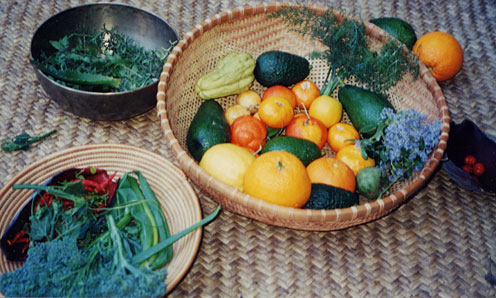
One day's harvest from an edible landscape that produces approximately 1000 lbs per year
of food on 1/8th acre with far less water than a lawn uses.
Helpful Preparation
 |
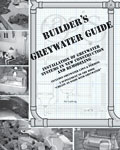 |
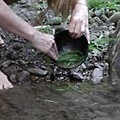 |
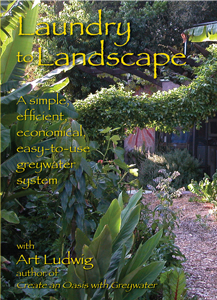 |
The more of the background info below you understand (or have been exposed to) before coming, the more you will get out of the presenation.
The following is worth reading all the way through:
- Eco Design Principles-download
- Laundry to landscape
- Oasis greywater-book
- Santa Barbara city greywater information
- GW site assessment checklist-pdf
- Common greywater mistakes
- Stub outs
- Rainwater Harvesting for Drylands (book by Brad Lancaster)
Resources mentioned in the talk
- Fruit tree chart(xls, PDF)
- How to measure Perk
- Eco home checklist-pdf
- Water testing-download
- Laundry to landscape parts
- Laundry to landscape installers
Sponsored by City of Santa Barbara Water Conservation Program and the Sweetwater Collaborative
Laundry to Landscape Installation Workshop
Friday October 17th 8:30 am til afternoon (subject to confirmation)
Geared towards professionals interested in installing greywater systems
Workshop logistics
Cost: TBA.
Registration: To register, please contact Madeline Ward at maward@santabarbaraca.gov, or call (805) 897-2672. Space is limited, register today! Priority will be given to landscape professionals, homeowners will be admitted on a space available basis. Please indicate with your registration if you are a landscape professional, and if so, your company affiliation.
Preparation: The Greywater Presentation will cover the backgound needed to make the most of the workshop, including water budgets, site plans, elevations. Attendence of the presenation is highly recommended; the material covered that evening will not be gone over again in the workshop. WatchingLaundry 2 landscape-videoand readingOasis greywater-bookalso helpful (for more prep see below).
Location: Residence in Santa Barbara. Exact address will be given with registration.
The workshop will consist of a mix of interactive discussion about the site, and hands-on demonstrations/work on the land. Wear work clothes and bring gloves and shovels.
Instruction will be in English, but Art has years of exposure to Spanish on projects in the US and Mexico and can provide clarification as needed in Spanish.
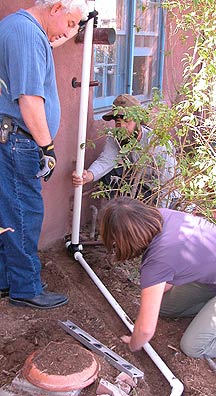 What the Workshop Will Explore
What the Workshop Will Explore
An entire Laundry to landscape system will be installed at a residence in Santa Barbara, from start to finish. This is the simplest, least expensive, lowest effort way to irrigate with residential greywater, and the most economically and ecologically viable to install professionally.
Other topics:
- Why greywater matters
- Streamlined permitting and compliance
- Site assessment; mapping, surveying elevations, perk test
- Advantages and issues with simple greywater systems
- Laundry to landscape system; advantages and limitations
- Simple supply, emitter flow and soil loading calculations
- Systems design, parts, parts sources, how to estimate costs
- Sample system components show and tell
- Installation tips and tricks
- Mulch basins specifications for laundry
- Attendee design clinic: Bring a background site map, photos and site assessment from your own project for possible use in this clinic
- If time permits, we will discuss other system options and business suggestions
Helpful Preparation
 |
 |
 |
 |
The more of the background info below you understand (or have been exposed to) before coming, the more you will get out of the workshop.
The following is worth reading all the way through:
- Laundry 2 landscape-video
- Laundry to landscape
- Oasis greywater-book
- Santa Barbara city greywater information
- GW site assessment checklist-pdf
- Common greywater mistakes
- Stub outs
This stuff will add more depth if you can scan or read any of it:
- Greywater Action
- Previous Laundry to Landscape presentation
- Fruit tree chart(xls, PDF)
- Stub outs & collection plumbing checklist (PDF)
- Eco Design Principles-download
- Eco home checklist-pdf
- Water testing-download
- Water Calculations Spreadsheet
- Rainwater Harvesting for Drylands (book by Brad Lancaster)
- Water Storage-book
If you are interested in policy, check out these pages:
Sponsored by City of Santa Barbara Water Conservation Program and the Sweetwater Collaborative

Video featuring clips from workshop and lectures on this page by City of Santa Barbara
The Joy of Lawn Replacement
Thursday October 30th 2014
7-8:30 pm
Faulkner Gallery, Santa Barbara Public Library
How you can save Santa Barbara and the world by replacing your lawn with natives and/or fruit trees. You can do so much better than grass, and with less water…
Free
Sponsored by SB Water Conservation, Sweetwater collaborative
See inspiring examples; learn how to do much better than grass with less water, time and money.
Lawn is one of Santa Barbara city’s biggest water uses. In the case of ornamental lawns, there’s especially little to show for all the money, maintenance, water and chemicals sunk into what is basically a landscape fashion from the last millennium.
Get ahead of the curve and learn how to improve—
- your and the city’s water budget
- outdoor living space
- water efficiency
- water harvesting and infiltration
- microclimate improvement
- privacy
- food production
- beauty
- ecology
- climate effects
- biodiversity
See real life examples from audience members, and learn how to apply these principles to clients’ and your own yards.
For landscape architects, landscapers, architects, and homeowners.
Background reading
The Problem of Lawns
...Historically, lawns first became popular among the gentry of Western Europe, where they were managed either as pasture or by labor-intensive hand sheering or scything. The modern lawn seems to be a deprecated form of the highly manicured English landscape gardens which became popular among the nobility in Britain in the 17th and 18th centuries. But wasn’t until the 19th century with the invention and mass production of the lawnmower that lawns really took off in North America.
Today, American lawns occupy some 30-40 million acres of land. Lawnmowers to maintain them account for some 5 percent of the nation’s air pollution – probably more in urban areas. Each year more than 17 million gallons of fuel are spilled during the refilling of lawn and garden equipment—more than the oil that the Exxon Valdez spilled.
Homeowners spend billions of dollars and typically use 10 times the amount of pesticide and fertilizers per acre on their lawns as farmers do on crops; the majority of these chemicals are wasted due to inappropriate timing and application. These chemicals then runoff and become a major source of water pollution.Last but not least, 30 to 60 percent of urban fresh water is used on lawns. Most of this water is also wasted due to poor timing and application...
American Green: The Obsessive Quest for the Perfect Lawn
The often-crazed love affair between Americans and their lawns is Ted Steinberg's subject in "American Green." Mr. Steinberg, an environmental historian at Case Western Reserve University in Cleveland, likens this relationship, and the insane pursuit of lawn perfection, to obsessive-compulsive disorder, and he may very well be right. That would at least explain the behavior of a homeowner who clips her entire front yard with a pair of hand shears, or Richard Widmark's reaction on waking up in the hospital after a severe lawn mower accident in 1990. "The question I asked the doctors was not 'Will I ever act again?' " he later recalled, "but 'Will I ever mow again?' "
How did a plant species ill suited to the United States, and the patrician taste for a rolling expanse of green take root from the shores of the Atlantic to the desiccated terrain of Southern California? The short answer is that it didn't, not until after the Civil War.
Sponsored by City of Santa Barbara Water Conservation Program and the Sweetwater Collaborative
More before and after images...

Sierra Water Reuse Conference
November 3-6 2014. Evergreen Lodge at Yosemite
33160 Evergreen Road, Groveland, California
Check Sierrawatershedprogressive.com for coming details...
Central Coast Sustainability Summit
Thursday November 13th 2014, 8am – 4pm. Loma Pelona Conference Center, UCSB
This year’s themes:
Water
The Central Coast is experiencing an unprecedented drought, with the driest consecutive three years on record and current city water supplies severely reduced, water is on everyone’s mind. At this year’s summit, we hope to share best practices and build collaborations that will help address water shortage and quality issues on the Central Coast.
Energy
Energy and water are intimately intertwined, energy is used to secure, deliver, treat, and distribute water, while water is used to develop, process, and deliver energy. Climate Change acts as a stressor to already scarce water resources on the Central Coast. At this year’s conference we will explore the energy water nexus, best energy management practices, community choice aggregation (CCA), and renewable energy projects, with potential opportunities for collaborate that can the benefit of Santa Barbara County.
Rainwater Runoff Harvesting
Tuesday November 18th 2014 (subject to confirmation)
6-7:30 pm
Faulkner Gallery, Santa Barbara Public Library
Free
As much water falls from the sky within Santa Barbara city limits as the city consumes in a year. Infiltrating more of this water into the ground instead of letting it run off has a host of benefits:
- Reduced irrigation use = lower water bills
- Flushing salt from soil= happier plants
- Reduced flooding
- More dry season creek flow
- Better creek water quality
- More water stored in the groundwater for later use
This presentation will cover—
- Why tanks and rain barrels have little use in our climate and storage in soil does
- Rainwater harvesting options; mulch basins, swales, infiltration basins
- Rainwater in the city and home water budget
- Location: groundwater recharge areas= extra good, landslide area= bad
- Sizing and designing basins and swales
- Examples
- Calculations
See real life examples, learn how to apply these principles to clients’ and your own yards.
For landscape architects, landscapers, architects, and homeowners.
Resources mentioned in the talk
- Water Calculations Spreadsheet
- Mulch Basins Flyer
- How to measure Perk
- Rainwater Harvesting for Drylands (book by Brad Lancaster)
- Runoff
Sponsored by City of Santa Barbara Water Conservation Program and the Sweetwater Collaborative
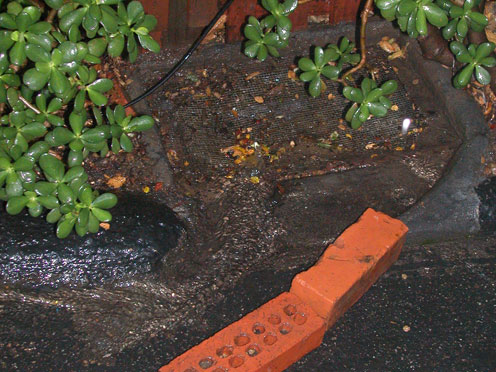
This little curb cut and filter captures 100,000 gallons a year of "run on," which reduces
our irrigation season by two-three weeks on each end, and adds 90,000 gallons to groundwater.
It cost about $200 in materials and took two days; about 50x the return of a tank system.
Rainwater and Runoff Harvesting Workshop
Friday November 21st 2014 8:30 am til afternoon(subject to confirmation)
Cost: TBA.
Registration: To register, please contact Madeline Ward at maward@santabarbaraca.gov, or call (805) 897-2672. Space is limited. Priority will be given to landscape professionals; homeowners will be admitted on a space available basis. Please indicate with your registration if you are a landscape professional, and if so, your company affiliation.
Preparation: Attendance of the Integrated Design and Rainwater Presentations is essential. Attending the Greywater and Lawn Replacement Presentations and readingRainwater Harvesting for Drylands (book by Brad Lancaster)would also be helpful.
Location: Santa Barbara City. Exact address will be given with registration.
This workshop will cover—
- Tour and critique of cityscape and yard(s) TBA
- Choice of techniques for a particular context
- Construction details of mulch basins and swales
- Connecting of downspouts
- Integration with greywater
- Integration with existing and new plantings
Sponsored by City of Santa Barbara Water Conservation Program and the Sweetwater Collaborative
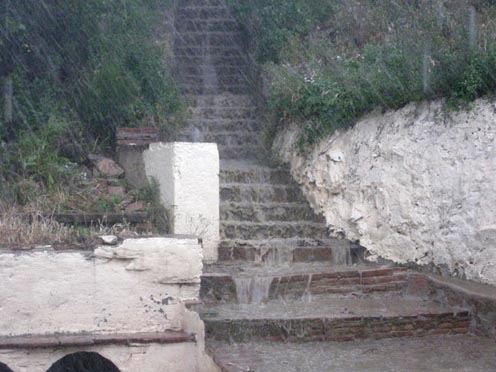
Stairs that double as channel to direct runoff to a 100,000 gallon cistern in Spain

The Way of the Bicycle
Bici Centro, Santa Barbara. Date in December 2014 TBA
Bike pix and tales from 8 years travel in 27 countries on dozens of junk bikes; a million vertical feet of mountain biking on one of the first mountain bikes on the south coast; ten years of bike design innovation and making custom transport bikes for people without cars; 40 years of bicycling for transportation; expert testimony on the true cost of cars.
…With a focus on the keystone role bikes have to play for the regeneration of mental, physical, economic and ecological health for our community, and more:
- Healthy is Sexy-The evolutionary biology of the bike meme
- Mountain bike your way to systems thinking
- The perfect bike for you
- How to make a bike that lasts 100 years
- Bike porn from Europe (and some nice pedestrian facilities too)
- Accounting for the true cost of cars
- How cars cost us 2000 acre feet a year of contaminated and lost water within Santa Barbara city limits alone
- The stunning contrast between the riding experience on Santa Barbara’s bikeway network and the deadly missing links
- The fork in the road: stranded infrastructure for mass car use vs Integrated Design for transportation
- After waving a magic wand over the transportation infrastructure, it would look like this…
- Key leverage points for getting a healthy mode split
Sponsored by Bici Centro

More Info
More books, downloads and other information in our Catalog.
.




